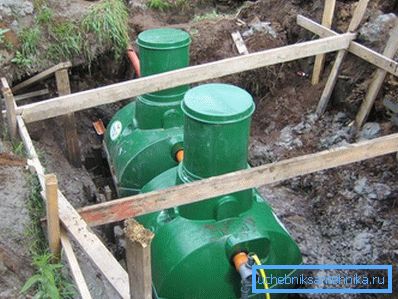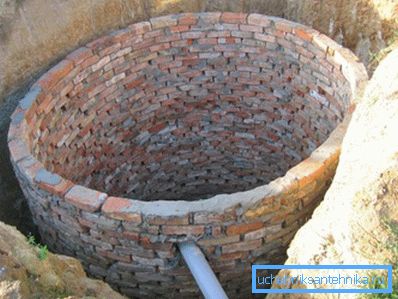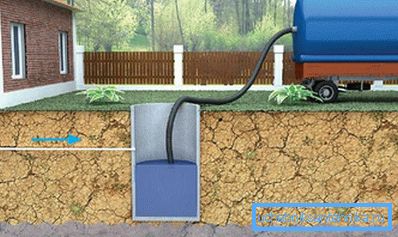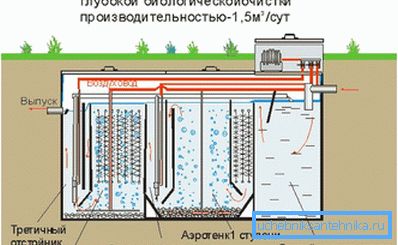Outdoor sewage yourself
Living in any country house today does not seem to be without utility amenities - a network of indoor and outdoor sewage. The device engineering structures, which begins after the release of domestic sewage beyond the lines of the house passes in several stages. External sewage with their own hands should be carried out on the basis of the project, developed according to the regulatory and technical documentation.
The device tanks for discharging wastewater
The essence of the construction of outdoor sewage is reduced to the transportation of wastewater to the end point, which may be a cesspool, filtration well, septic tank, biological treatment station or urban network.
Septic tank

A septic tank is a complex of several chambers, some of which are closed tightly. In them, sewage is settled and decomposed with the help of bacteria.
Tip! The volume of the septic tank should be designed for more than twice the daily rate of discharge of wastewater. With this ratio, the waste of vital processes will be defended for three days, which will allow the sediment to accumulate evenly throughout the year, and the purified liquid seep into the ground through a separate chamber.
If the septic tank is properly designed and properly operated, pumping waste can be very rare.
For example, a septic tank with a capacity of 1 m? / Day differs in the following sizes:
- dimensions - 1? 1,5 m;
- hatch diameter - 1.5 m;
- dig in a septic tank to a depth of 2.5 m;
- the septic tank should be at a distance of 5.0 × 20 m from the house in the corridor.
You can not use a factory-made septic tank, but make it yourself from barrels that will play the role of tanks, and their wall thickness should be more than 7 mm. In addition, the material from which the barrels are made must be distinguished by a neutral reaction to aggressive media.

Not less often installation of the external sewerage is made by means of a septic tank from can of rings:
- at a certain place, a hole of necessary depth is being dug and filled with concrete;
- for the next two tanks there is no need to make a concrete pillow. The pit in diameter should exceed the dimensions of the rings by approximately 0.25 m;
- after the rings are mounted on each other, the joints between them are sealed;
- tanks are interconnected by means of pipes, which must have a slope with respect to the next treatment tank;
- The installation of a septic tank made of reinforced concrete rings is completed by installing the hatches over each compartment.
Cesspit

A cesspool is a pit, whose walls are reinforced with brick or concrete. Periodically, the pit is cleaned with a cesspool machine. Such facilities are built with a small amount of wastewater.
According to sanitary norms, it is forbidden to make a cesspool without a prepared bottom.
Many owners of country houses ignore this rule. When wastewater flow is up to 1 m? / Day, self-cleaning of sewage takes place with the help of soil, but this does not mean there is no danger of contamination of groundwater with harmful substances. A cesspool equipped with a bottom is a single-chamber septic tank.

Such pits have their drawbacks:
- large volumes of wastewater are not amenable to filtration;
- when using a monolithic construction, periodic pumping is required;
- financial costs of the sewage truck, for which, in addition, it is necessary to provide for the possibility of approaching the tank;
- high probability of spreading an unpleasant smell.
Tip! If the house is operated continuously, the use of a sump is not recommended.
Biological treatment stations

Biological treatment stations are small-sized structures, the degree of sewage treatment in which reaches 98%. Among all the tanks for discharging wastewater, they are considered the most effective, but they have several disadvantages. The cost of biostation is quite high, they require professional maintenance from time to time. In addition, their work requires electrical energy.
Each option has its advantages and disadvantages.
Device external networks

Installation of external sewage is carried out according to certain rules that meet the SNiP 2.04.03-85.
- From the basement of the house, an external sewage pipeline is discharged and laid at a certain depth to the urban system or the final tank. For sewer external network used pipes made of cast iron, ceramic, asbestos cement or plastic. The last option is by far the most in demand, since plastic pipes are relatively cheap, they are easy to install and have the right amount of shaped parts in the kit. Among the popular pipes can be distinguished polypropylene, PVC and polyethylene. The inner walls of products should be perfectly smooth, which will allow in the future to avoid unwanted blockages. If you plan to operate the sewage all year round, you need to ensure that the pipelines are laid no higher than the depth of soil freezing. If it is impossible to meet this condition, the pipes are insulated with mineral wool or other insulation.
- Under the pipelines dig trenches to a depth determined by the project, while the groundwater level should not rise to the level of the laid sewage (using data from geological and geodetic exploration). The depth of the strip should be approximately 1.5 m.
- Elements of the gravity system are laid with a certain slope, which depends on the diameter of the pipe. Approximate slope can be calculated by dividing 1 / D.
- To avoid mechanical damage and for better thermal insulation, the bottom of the trench is leveled with a layer of clay and sand. In the process of making a sand-clay pad, it is compacted.
- In the places of change of direction and every 20 m in the straight sections are installed inspection wells.
- Backfill ditches produce sand and soil in order. While the sand has not hidden the pipeline, it is tamped on its sides. When the pipes are already covered with sand, the seal is stopped.
The finished network can be connected to the cleaning tank. In this case, you should always remember about the need for regular inspection and maintenance of data of engineering structures.
Video
This video tells about the device external sewage in a large country house.